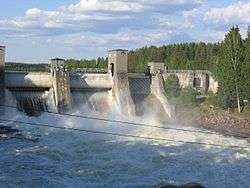Imatra
| Imatra | ||
|---|---|---|
| Town | ||
| Imatran kaupunki | ||
|
The dam of Imatra | ||
| ||
 | ||
| Coordinates: 61°11′N 028°46′E / 61.183°N 28.767°ECoordinates: 61°11′N 028°46′E / 61.183°N 28.767°E | ||
| Country | Finland | |
| Region | South Karelia | |
| Sub-region | Imatra sub-region | |
| Charter | 1948 | |
| Government | ||
| • Town manager | Pertti Lintunen | |
| Area (2011-01-01)[1] | ||
| • Total | 191.28 km2 (73.85 sq mi) | |
| • Land | 154.99 km2 (59.84 sq mi) | |
| • Water | 36.29 km2 (14.01 sq mi) | |
| Area rank | 307th largest in Finland | |
| Population (2016-03-31)[2] | ||
| • Total | 27,721 | |
| • Rank | 38th largest in Finland | |
| • Density | 178.86/km2 (463.2/sq mi) | |
| Population by native language[3] | ||
| • Finnish | 97% (official) | |
| • Swedish | 0.1% | |
| • Others | 2.9% | |
| Population by age[4] | ||
| • 0 to 14 | 13.8% | |
| • 15 to 64 | 64.1% | |
| • 65 or older | 22.1% | |
| Time zone | EET (UTC+2) | |
| • Summer (DST) | EEST (UTC+3) | |
| Municipal tax rate[5] | 19.5% | |
| Climate | Dfc | |
| Website | www.imatra.fi | |
Imatra (Russian: Иматра) is a town and municipality in eastern Finland. Imatra was founded in 1948 on the territory of three municipalities – Jääski, Ruokolahti and Joutseno. Finland ceded 11% of its territory to the Soviet Union after the Winter War. Jääski lost 85% of its territory and it was decided that a new municipality, Imatra, should be established on the remaining 15% of Jääski and some areas of Ruokolahti and Joutseno. This is why the Imatra coat of arms has three flashes – in honour of those previous municipalities that granted areas to it. Imatra is dominated by Lake Saimaa, the Vuoksi River and the border. It gained its municipal charter in 1971.
On the other side of the border, 7 kilometres (4 mi) away from the centre of Imatra, lies the Russian town of Svetogorsk. St Petersburg is situated 210 km (130 mi) to the southeast, Finland's capital Helsinki is 230 km (140 mi) away and Lappeenranta, the nearest Finnish town, is 37 km (23 mi) away. Imatra belongs to the administrative province of Southern Finland and the region of South Karelia.
An Art Nouveau or Jugend style castle, currently known as Imatran Valtionhotelli, was built near the rapids in 1903 as a hotel for tourists from the Russian Imperial capital Saint Petersburg.
The main employers are Stora Enso Oyj, Town of Imatra, Ovako Bar Oy Ab and the Finnish Border Guard. As of October 2003, total number of employees was 12,423.[6] As of December 2004, 1,868 employees were employed by the Town of Imatra.
Imatra is the birthplace of National Hockey League players Jussi Markkanen and Petteri Nokelainen.
The mayor of Imatra is Pertti Lintunen.
In motorsport history, Imatra is best known for its road races (former TT-race) from 1963 to 1986. From 1962 to 1982 it was the home of the Finnish motorcycle Grand Prix.
During the Continuation War, Carl Gustaf Emil Mannerheim met with Adolf Hitler in secrecy near the town for the former's 75th birthday.
International relations
Twin towns — Sister cities
-
 Ludvika, Sweden
Ludvika, Sweden -
 Salzgitter, Germany
Salzgitter, Germany -
 Zvolen, Slovakia
Zvolen, Slovakia -
 Tikhvin, Russia
Tikhvin, Russia -
 Szigetvár, Hungary
Szigetvár, Hungary -
 Narva-Jõesuu, Estonia
Narva-Jõesuu, Estonia
Gallery
-

Passport entry stamp from the border checkpoint
-

Passport exit stamp from the border checkpoint

References
- ↑ "Area by municipality as of 1 January 2011" (PDF) (in Finnish and Swedish). Land Survey of Finland. Retrieved 9 March 2011.
- ↑ "Ennakkoväkiluku sukupuolen mukaan alueittain, maaliskuu.2016" (in Finnish). Statistics Finland. Retrieved 31 March 2016.
- ↑ "Population according to language and the number of foreigners and land area km2 by area as of 31 December 2008". Statistics Finland's PX-Web databases. Statistics Finland. Retrieved 29 March 2009.
- ↑ "Population according to age and gender by area as of 31 December 2008". Statistics Finland's PX-Web databases. Statistics Finland. Retrieved 28 April 2009.
- ↑ "List of municipal and parish tax rates in 2011". Tax Administration of Finland. 29 November 2010. Retrieved 13 March 2011.
- ↑ Imatra town homepage
- ↑ "Ystävyyskaupungit" (in Finnish). Imatran kaupunki. Retrieved 2015-01-23.
External links
![]() Media related to Imatra at Wikimedia Commons
Media related to Imatra at Wikimedia Commons
- Town of Imatra – Official site
 Imatra travel guide from Wikivoyage
Imatra travel guide from Wikivoyage- goSaimaa.com – Travel information about Imatra


